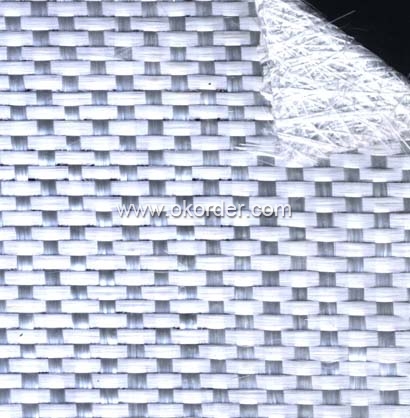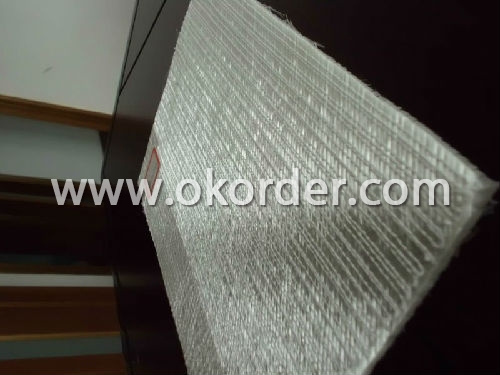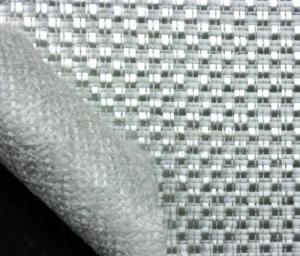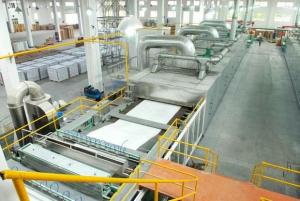Fiberglass Stitch Combo Mat
- Loading Port:
- China Main Port
- Payment Terms:
- TT or L/C
- Min Order Qty:
- One Pallet kg
- Supply Capability:
- 20 days for 1 x 20FCL kg/month
OKorder Service Pledge
OKorder Financial Service
You Might Also Like
Application of Fiberglass Stitch Combo Mat
Name: | E-Glass Stitch Combo Mats |
Lead Time: | 20 days for 1 x 20FCL |
MinOrder: | One Pallet |
Package: | Plastic Bag, Carton and Pallet |
Characteristic of Fiberglass Stitch Combo Mat
The special product construction where 0°,90°rovings are parallel aligned without crossing facilities resin impregnation in the layers of chopped strands, resulting in higher productivity and reduced consumption of resins.
The multi-layer structure delivers increased area weight and simplifies the manufacturing process of the composite products, resulting in improve molding productivity and reduced cost.
The composite products feature multi-directional and balanced mechanical properties.
Package of Fiberglass Stitch Combo Mat
Each stitch combo mat is wounded onto a paper tube which has an inside diameter of 73mm, and the roll has a diameter of 260mm. The roll is wrapped up with plastic film, and then packed in a cardboard box or wrapped up with kraft paper. The rolls are to be horizontally placed. For transporation the rolls can be loaded into a container directly or on pallets.
Storage of Fiberglass Stitch Combo Mat
Unless otherwise specified, fiberglass products should be stored in a dry, cool and rain-proof area. It is recommended that the room temperature and humidity should be always maintained at 15℃-35℃ and 35%-65% respectively.
Standard:ISO 9001


- Q:Can fiberglass fabrics be used for reinforcement in plastic products?
- Indeed, fiberglass fabrics have the ability to be used as reinforcement in plastic products. Renowned for their exceptional strength and durability, fiberglass fabrics prove to be an optimal selection when it comes to fortifying plastic materials. Typically, the fiberglass fabric is saturated with a resin, which, upon solidification, forms a robust and inflexible composite structure. This reinforcement aids in enhancing the mechanical properties of the plastic product, such as augmenting its tensile strength, rigidity, and ability to withstand impacts. Moreover, fiberglass fabrics provide outstanding dimensional stability and resistance to chemicals, rendering them suitable for a wide variety of plastic applications. All in all, fiberglass fabrics are highly favored for their unparalleled strength and performance characteristics in the realm of reinforcing plastic products.
- Q:What are the differences between Geogrid, glass fiber network and geotextile?
- Geotextile has excellent filtration, drainage, isolation, reinforcement, seepage prevention and protection. It has light weight, high tensile strength, good permeability, high temperature resistance, cold resistance, aging resistance and corrosion resistance. Common non-woven fabrics, water used inside the layer, polyethylene polypropylene waterproof also used.
- Q:How does fiberglass fabric perform in terms of chemical stability?
- Fiberglass fabric demonstrates excellent chemical stability, making it highly resistant to various chemicals, acids, and alkalis. It does not degrade or react with most chemicals, ensuring its durability and longevity in harsh chemical environments.
- Q:How is fiberglass fabric used in the production of soundproof curtains?
- Fiberglass fabric is commonly used in the production of soundproof curtains due to its excellent acoustic properties. The fabric is made from woven fibers of glass, which are highly effective in absorbing and dampening sound waves. In the production process, layers of fiberglass fabric are typically sandwiched between other fabric materials to create a multi-layered curtain. These layers work together to effectively block and absorb sound, providing a barrier that helps reduce noise transmission through windows or doors. The use of fiberglass fabric in soundproof curtains offers several benefits. Firstly, fiberglass is a lightweight material, which makes the curtains easy to handle and install. Additionally, fiberglass has a high tensile strength, ensuring the curtains remain durable and long-lasting. Moreover, the fibers of fiberglass fabric are designed to trap and absorb sound waves, converting them into heat energy. This acoustic absorption property helps to reduce echo and reverberation within a room, creating a quieter and more comfortable environment. Furthermore, fiberglass fabric is resistant to moisture, mold, and mildew, making it suitable for use in various settings, including residential, commercial, and industrial spaces. It is also fire-resistant, adding an extra layer of safety to soundproof curtains. Overall, fiberglass fabric plays a crucial role in the production of soundproof curtains by enhancing their ability to block and absorb sound waves effectively. The combination of its acoustic properties, durability, and resistance to various environmental factors makes fiberglass fabric an ideal choice for creating soundproofing solutions.
- Q:What are the different coating options available for fiberglass fabric?
- There are several coating options available for fiberglass fabric. These coatings are designed to enhance the fabric's properties and make it suitable for various applications. 1. Silicone Coating: Silicone coating provides excellent heat resistance and can withstand high temperatures. It also offers good chemical resistance, making it suitable for applications in industries such as aerospace, automotive, and insulation. 2. Polyurethane Coating: Polyurethane coating provides a durable and flexible finish to fiberglass fabric. It offers good abrasion resistance, waterproofing, and UV stability. This coating is commonly used in applications like outdoor covers, tents, and awnings. 3. PTFE Coating: PTFE (Polytetrafluoroethylene) coating is known for its non-stick properties and high resistance to chemicals, heat, and weathering. It provides excellent electrical insulation and low friction properties. PTFE coated fiberglass fabric is commonly used in applications such as conveyor belts, release sheets, and insulation. 4. Acrylic Coating: Acrylic coating provides a smooth finish and enhances the fabric's durability and strength. It offers good resistance to UV rays, mildew, and abrasion. This coating is commonly used in applications like marine covers, outdoor furniture, and bags. 5. Neoprene Coating: Neoprene coating provides excellent resistance to oil, chemicals, and weathering. It also offers good flame resistance and flexibility. This coating is commonly used in applications such as protective clothing, gloves, and industrial curtains. 6. Vinyl Coating: Vinyl coating provides a waterproof and durable finish to fiberglass fabric. It offers good resistance to UV rays, abrasion, and chemicals. This coating is commonly used in applications like outdoor furniture, truck covers, and pool liners. These are just a few examples of the different coating options available for fiberglass fabric. The choice of coating depends on the specific requirements of the application, such as heat resistance, chemical resistance, flexibility, and durability.
- Q:How does fiberglass fabric handle chemicals and solvents?
- Fiberglass fabric is known for its excellent resistance to a wide range of chemicals and solvents. The unique properties of fiberglass, such as its non-reactivity and high chemical resistance, make it an ideal material for various industries that deal with corrosive substances. The structure of fiberglass fabric, which is composed of woven glass fibers, provides exceptional resistance to chemical attack. It is highly resistant to most acids, bases, and organic solvents. This makes it suitable for applications where exposure to corrosive chemicals is common, such as in chemical processing plants, laboratories, and oil refineries. One of the key advantages of fiberglass fabric is its ability to maintain its physical integrity and mechanical strength when exposed to various chemicals and solvents. Unlike some other materials that can degrade or become brittle when in contact with certain substances, fiberglass fabric remains stable and durable. This ensures that it can withstand the harsh conditions and continue to perform effectively over extended periods. Another benefit of fiberglass fabric is its low permeability to chemicals and solvents. This means that it acts as a barrier, preventing the passage of harmful substances through its surface. This property is particularly valuable in applications where containment is crucial, such as in storage tanks, pipelines, and chemical-resistant linings. In addition to its resistance to chemicals and solvents, fiberglass fabric also offers other desirable properties. It is lightweight, flexible, and has excellent thermal insulation properties. These characteristics make it a versatile material that can be used in a wide range of applications where both chemical resistance and structural integrity are required. However, it is important to note that while fiberglass fabric is highly resistant to most chemicals and solvents, there are some exceptions. Certain strong acids, such as hydrofluoric acid, can attack fiberglass and cause degradation. Additionally, prolonged exposure to certain solvents like acetone or chloroform may cause swelling or softening of the fabric. Overall, fiberglass fabric is a reliable and durable material that can handle a wide range of chemicals and solvents. Its excellent chemical resistance, combined with its other beneficial properties, make it a preferred choice for many industries where protection against corrosive substances is essential.
- Q:How does fiberglass fabric perform in weight-to-strength ratio?
- Fiberglass fabric possesses a weight-to-strength ratio that is relatively high, indicating its lightweight nature alongside significant strength and durability. This attribute stems from the unique composition of fiberglass, comprising minute glass fibers interwoven together. These fibers are incredibly robust and inflexible, enabling the fabric to withstand substantial levels of tension and compression. When compared to materials like steel or aluminum, fiberglass fabric is considerably lighter while still maintaining comparable strength. This characteristic renders it an optimal selection for situations where weight holds critical importance, such as in the aerospace or automotive sectors. Furthermore, the fabric's high strength permits the construction of structures and components capable of enduring heavy loads without excessive weight addition. By adjusting the weave pattern and the density of the glass fibers, the weight-to-strength ratio of fiberglass fabric can be further optimized. For instance, a tighter weave or increased fiber density can enhance the fabric's strength, albeit potentially increasing its weight. Conversely, a looser weave or reduced fiber density can reduce weight, albeit potentially compromising some strength. All in all, fiberglass fabric exhibits commendable performance in terms of its weight-to-strength ratio, presenting a lightweight and robust material applicable across a broad range of fields. Its versatility and durability render it a popular choice within various industries where the balance between weight and strength holds crucial significance.
- Q:How is fiberglass fabric used in the marine industry?
- Fiberglass fabric is commonly used in the marine industry for its strength, durability, and resistance to corrosion. It is used in the construction of boats, yachts, and other watercraft to reinforce the hull, decks, and cabin structures. The fabric is often combined with resin to create a composite material that provides excellent structural integrity, making the vessels more lightweight and fuel-efficient. Additionally, fiberglass fabric is used to manufacture components like hatches, panels, and insulation, as it offers good thermal and sound insulation properties.
- Q:Can fiberglass fabric be used for airbags?
- Airbags can indeed utilize fiberglass fabric. Renowned for its durability and ability to resist heat, fiberglass fabric proves suitable for endeavors demanding both safety and endurance. Given their pivotal role in vehicle safety, airbags must endure immense impact and rapid inflation. Fortunately, fiberglass fabric endows them with the necessary strength and resilience to handle such demanding circumstances. Moreover, this material boasts a lightweight and flexible nature, allowing it to be easily molded into diverse shapes, rendering it an ideal choice for airbags. In conclusion, fiberglass fabric stands as a highly reliable and frequently employed material for airbags, thanks to its exceptional strength-to-weight ratio and capacity to withstand the harshest of conditions.
- Q:Can fiberglass fabric be used for making roller blinds?
- Yes, fiberglass fabric can be used for making roller blinds. Fiberglass fabric is a popular choice for roller blinds due to its durability and strength. It is resistant to moisture and UV rays, making it suitable for use in both indoor and outdoor settings. Additionally, fiberglass fabric is lightweight, allowing for easy operation and maintenance of roller blinds. The fabric is also available in a variety of colors and patterns, providing flexibility in design options. Overall, fiberglass fabric is a reliable and practical choice for making roller blinds.
1. Manufacturer Overview |
|
|---|---|
| Location | Zhejiang, China |
| Year Established | 1969 |
| Annual Output Value | Above US$ 150 Million |
| Main Markets | overseas companies in Hongkong, Canada, South Africa, South Korea, India, Italy, Singapore, France and many other countries and regions. |
| Company Certifications | ISO9001;ISO14001 |
2. Manufacturer Certificates |
|
|---|---|
| a) Certification Name | |
| Range | |
| Reference | |
| Validity Period | |
3. Manufacturer Capability |
|
|---|---|
| a)Trade Capacity | |
| Nearest Port | Shanghai |
| Export Percentage | 40%-50% |
| No.of Employees in Trade Department | 21-50 People |
| Language Spoken: | English |
| b)Factory Information | |
| Factory Size: | Above 5000,000 square meters |
| No. of Production Lines | Above 5 |
| Contract Manufacturing | |
| Product Price Range | Average |
Send your message to us
Fiberglass Stitch Combo Mat
- Loading Port:
- China Main Port
- Payment Terms:
- TT or L/C
- Min Order Qty:
- One Pallet kg
- Supply Capability:
- 20 days for 1 x 20FCL kg/month
OKorder Service Pledge
OKorder Financial Service
Similar products
New products
Hot products
Related keywords





























